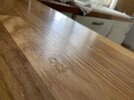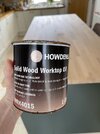Danish oil is generally formulated to give a matt or semi-matt finish. It was originally meant specifically for tropical hardwoods such as teak, iroko and some mahoganies which were commonly used in Scandinavian furniture in the 1950s and 60s and where a matt finish works well with the colour of the timber. Personally I doubt it will work well on a lighter, non-tropical hardwood.
A traditional oil finish, boiled linseed oil (BLO) gives a glossier finish as it cures fully (AFAIK Danish oil doesn't cure). I suspect that the Howdens oil you reference will contain a good percentage of BLO and/or possibly polymerised tung oil. There are also the so-called hardwax oils, but I only have limited experience of those to date, so I'd prefer it if someone more knowledgeable gave you info about those
Note that BLO is NOT just "linseed oil" or "raw linseed oil" it has to be specifically called "boiled linseed oil".
IMPORTANT: Boiled linseed oil cures exothermically on contact with air, so containers holding it most be sealed after use to prevent them starting to cure in the can. Because BLO cures exothermically (in other words it generates heat as it cures) you should NEVER leave impregnated cloths in bundles or scrunched up. Before discarding the cloths lay them flat outside to dry, to avoid a fire hazard. Believe it or not a rolled up ball of cloth rag soaked with BLO can catch fire! (the finish on the worktop, however, won't)



